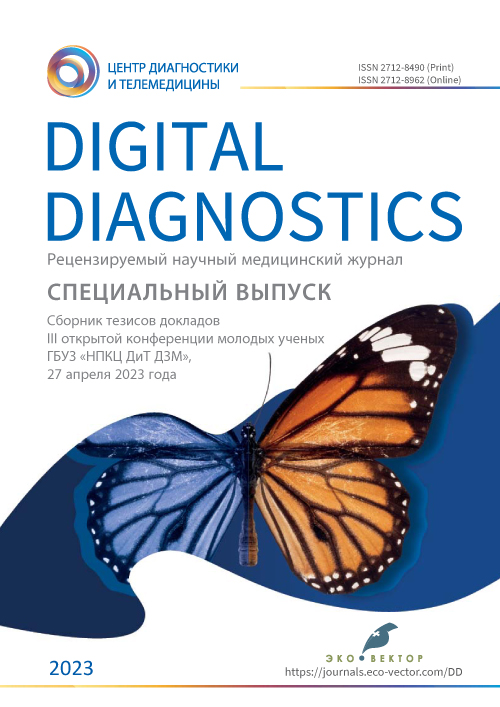Magnetic resonance imaging of the temporomandibular joint: An integrative approach
- Autores: Dushkova D.V.1, Vasilev Y.A.2, Lezhnev D.A.3
-
Afiliações:
- K+31
- Scientific and Practical Clinical Center for Diagnostics and Telemedicine Technologies
- A.I. Yevdokimov Moscow State University of Medicine and Dentistry
- Edição: Volume 4, Nº 1S (2023)
- Páginas: 50-52
- Seção: Conference proceedings
- ##submission.dateSubmitted##: 18.05.2023
- ##submission.dateAccepted##: 18.05.2023
- ##submission.datePublished##: 26.06.2023
- URL: https://jdigitaldiagnostics.com/DD/article/view/430342
- DOI: https://doi.org/10.17816/DD430342
- ID: 430342
Citar
Texto integral
Resumo
BACKGROUND: According to various data, orofacial diseases occur in the population in 20%–85% of cases. The most common cause of maxillofacial pain unrelated to the dental system is temporomandibular joint (TMJ) dysfunction, which is defined as a disruption of the anatomical relationship during natural movements. Magnetic resonance imaging (MRI) is the method of choice for diagnosing joint pathology.
AIM: MRI with static, pseudodynamic, and dynamic protocols were optimized for targeted diagnosis of TMJ dysfunction.
METHODS: Classical examination of the TMJ is performed in a closed and open mouth position. However, the images obtained do not reflect the location of the intra-articular disc at all stages of mandibular motion.
RESULTS: After a static examination in two oral positions, pseudodynamic sagittal T1 weighted imaging (WI) scans were obtained. The patient was asked to divide the movements from full closure to full mouth opening into five steps. The examination was conducted with the MRI operator and the patient acting together. The scans assessed the position and shape of the meniscus at five stages of mandibular movements. The performed program is leading in the assessment of the disc shape changes at each stage of the mouth opening. Wide coverage of the studied area allows to visualize both articular relations of internal structures and surrounding soft tissues, including contraction of the lateral wing muscle and superficial and deep parts of the masseter muscle. The final stage was a dynamic T2 WI scan performed by the patient individually. The obtained series of images represents sequential movements of the condyle, maximally approximating the natural mouth opening. The pulse sequence helps to assess the amplitude of motion of the mandibular condyle and hypermobility, which can be difficult when performing static images with standard mouth expanders.
CONCLUSIONS: An optimized dynamic and pseudodynamic TMJ study protocol is an essential part of the precise diagnosis of TMJ dysfunction and allows for differential diagnosis between muscle spasm and intra-articular disc adhesion and reliable visualization of intra-articular relationships during mouth opening.
Palavras-chave
Texto integral
BACKGROUND: According to various data, orofacial diseases occur in the population in 20%–85% of cases. The most common cause of maxillofacial pain unrelated to the dental system is temporomandibular joint (TMJ) dysfunction, which is defined as a disruption of the anatomical relationship during natural movements. Magnetic resonance imaging (MRI) is the method of choice for diagnosing joint pathology.
AIM: MRI with static, pseudodynamic, and dynamic protocols were optimized for targeted diagnosis of TMJ dysfunction.
METHODS: Classical examination of the TMJ is performed in a closed and open mouth position. However, the images obtained do not reflect the location of the intra-articular disc at all stages of mandibular motion.
RESULTS: After a static examination in two oral positions, pseudodynamic sagittal T1 weighted imaging (WI) scans were obtained. The patient was asked to divide the movements from full closure to full mouth opening into five steps. The examination was conducted with the MRI operator and the patient acting together. The scans assessed the position and shape of the meniscus at five stages of mandibular movements. The performed program is leading in the assessment of the disc shape changes at each stage of the mouth opening. Wide coverage of the studied area allows to visualize both articular relations of internal structures and surrounding soft tissues, including contraction of the lateral wing muscle and superficial and deep parts of the masseter muscle. The final stage was a dynamic T2 WI scan performed by the patient individually. The obtained series of images represents sequential movements of the condyle, maximally approximating the natural mouth opening. The pulse sequence helps to assess the amplitude of motion of the mandibular condyle and hypermobility, which can be difficult when performing static images with standard mouth expanders.
CONCLUSIONS: An optimized dynamic and pseudodynamic TMJ study protocol is an essential part of the precise diagnosis of TMJ dysfunction and allows for differential diagnosis between muscle spasm and intra-articular disc adhesion and reliable visualization of intra-articular relationships during mouth opening.
Sobre autores
Darya Dushkova
K+31
Autor responsável pela correspondência
Email: dduskova@yandex.ru
ORCID ID: 0000-0003-3011-6752
Rússia, Moscow
Yurii Vasilev
Scientific and Practical Clinical Center for Diagnostics and Telemedicine Technologies
Email: VasilevYA1@zdrav.mos.ru
ORCID ID: 0000-0002-0208-5218
Rússia, Moscow
Dmitry Lezhnev
A.I. Yevdokimov Moscow State University of Medicine and Dentistry
Email: lezhnevd@mail.ru
ORCID ID: 0000-0002-7163-2553
Rússia, Moscow
Bibliografia
- Dushkova DV, Vasil’ev YuA. The Role of Dynamic and Pseudodynamic Magnetic Resonance Research in the Diagnosis of Temporomandibular Joint Diseases. Radiologiâ-praktika. 2019;(6):21–32. (In Russ).
- Komolov IS, Vasil’ev AYu. Magnetic Resonance Imaging in Assessment of the Effect of Displacements of the Articular Disс in the Formation of the Pain Syndrome in Dysfunction of the Temporomandibular Joint. Radiologiâ-praktika. 2018;(2):20–27. (In Russ).
- Xiong X, Yin X, Liu F, Qin D, Liu Y. Magnetic resonance imaging-guided disc–condyle relationship adjustment via articulation: a technical note and case series. J Int Med Res. 2020;48(8):0300060520951052. doi: 10.1177/0300060520951052
- Kamel Z, El-Shafey M, Hassanien O, Nagy H. Can dynamic magnetic resonance imaging replace static magnetic resonance sequences in evaluation of temporomandibular joint dysfunction? Egyptian Journal of Radiology and Nuclear Medicine. 2021;52:1–15. doi: 10.1186/s43055-020-00396-8
Arquivos suplementares











